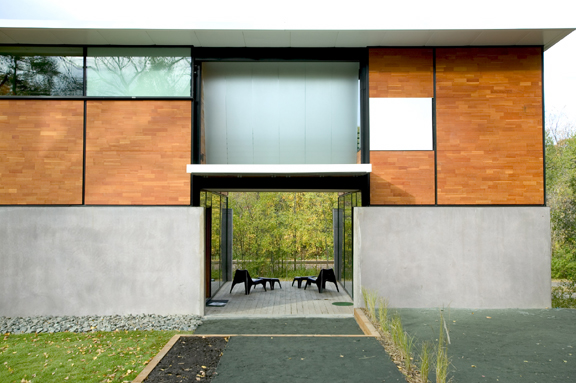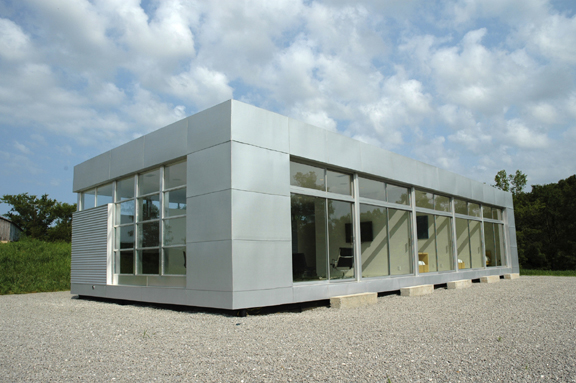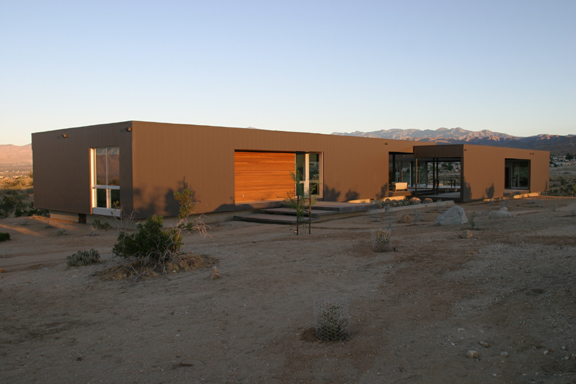New Prefab: Fabulous or Fable?
Stephanie Xenos looks at "Some Assembly Required," a show of new prefab designs at the Walker Art Center. She notes that architecture for the (middle-class) masses has taken a sharp turn toward modernism.




When you come to see the show, glance up the stairway from the gallery entrance. There’s a photo of a gloriously dissheveled Havana house interior by Robert Polidori that provides sharp and elegiac counterpoint to the spare dwellings in the show. Thanks to the good curatorial eye that provided the contrast . . .
Remember when you were a kid and you could spend hours drawing detailed pictures of what your house would look like when you grew up? Then, when you did in fact grow up, or at least became old enough to own a house of your own, those flights of fancy were crushed by the plodding reality; a choice falling somewhere between “this old home” and a “modern” planned community consisting of neo knockoffs. And since most of us follow the path of least resistance, that’s where things usually end. Just another gentle nudge to accept our lot and get on with it.
Then came prefab. Or, I should say, then came modern prefab. Prefab, or prefabricated housing, has been around for about a century. It might be tempting to say it’s in vogue again, but the scorn heaped on the lowly mobile homes and trailer parks that popped up in the post-WWII era suggest otherwise. Some Assembly Required: Contemporary Prefabricated Housing, currently on exhibit at the Walker and curated by Andrew Blauvelt, has come along at a moment of architectural zeitgeist, as the prefab comes out to the world with some attitude.
The exhibit offers a convincing narrative about the evolution of this much-maligned approach to building. The subtext comes through brilliantly, if unintendedly, as well. Wealth and poverty, globalization and sustainability, iconoclasm and conformity, all of these abstract dialogues surface time and again, threading through the language used to talk about modern prefab and the surprisingly complex and even beautiful designs themselves.
The tacit promise: a chance to reflect personal taste–both “ecological and aesthetic”–in the most visible way possible. Oh, if you can afford it.
As with everything, you get what you pay for with this stuff—so, though modern prefab may have shrugged off the association with the “shoddy construction and makeshift communities” attributed to mobile homes, it’s also shrugged off its association with the teeming masses in search of shelter … for now. When economies of scale become possible, though, you can expect to see cookie-cutter knock-offs populating a subdivision near you. When you consider the difference in price—a $175-$200-per-square-foot base price for Lazor Design’s FlatPak, say, versus $30-$40 per square foot for a new high-end double-wide mobile home—the line between utopian dream-home for the masses and a new option for the relatively affluent becomes clearer. What once would have been a home of last resort is reinvented as the next big thing in architecture.
Some Assembly Required does a good job of demonstrating the variety within this emerging category of architecture, from high-end, high-customization options to strictly modular dwellings that can be stacked and arranged, but take essentially the same form.
Two of the handful of examples of modern prefab spotlighted in Some Assembly Required have a local connection—the Flat Pak House, designed by Lazor in Minneapolis, and the weeHouse, designed by Alchemy Architects in St. Paul. The connection isn’t too surprising, given that Blauvelt has said that Minnesota is among the areas most active in the country in modern prefab design. And the centerpiece of the exhibit is an actual Flat Pak House surrounded by large color images and scale models of each structure.
The simple, self-contained design of the Flat Pak House hardly sparks thoughts of class and global economics on first glance, but one of the points made in the descriptive text stirs thought. “Lazor approaches the house as a series of components that are brought together for on-site assembly. This philosophy parallels modern product manufacturing … that allows parts to be fabricated elsewhere and assembled at the location.” That nod to globalization has interesting parallels to the history of the prefab idea itself. What started out as an inexpensive home for America’s blue-collar workforce has reinvented itself as the essence of the modern bourgeois lifestyle right down to the method of manufacture. But that’s not to say it’s a bad thing, just that it’s an interesting mirror on life in 21St century America.
The Lazor House and weeHouse tend to the simple, minimalist end of the modern prefab spectrum—all windows and light and right angles. On the other end of the spectrum you get the Turbulence House, which looks a little like an extremely scaled down Frank Gehry structure with its curved, sculptural, organic form. These structures represent the variety possible. But they also share a trait: an openness, a conversation even, with the surrounding environment. Leo Marmoll, one of the designers of the Desert House, puts it succinctly. “More of us can live in a house that doesn’t separate us from our environment.” A worthy goal, and the allure of windows and light are difficult to resist. It all seems to speak of well-laid plans and a life filled with both purposefulness and pleasure.
Yet how many of us live that way? On the one hand, modern prefab fulfills the highest hopes of modernism while still providing room for individual expression. But clean lines and openness of the interior to view also limit self-expression. The aesthetic, not unlike the ideals that inform LeCorbusier’s Radiant City, forces a certain amount of conformity on the space and its inhabitants. It demands that you subjugate personal taste to minimalism. Bottom line: it just doesn’t feel cozy. Modern prefab may, alas, be more a place to aspire to than to actually live. After all, if being in tune with our environment were really a philosophical imperative shared by the many, the landscape would look rather different than it does.
As I walk out of the exhibit and look out of the gallery’s floor-to-ceiling windows toward the Basilica, the contrast between modern prefab and the cathedral seems almost too perfect. One is meant to conform to the surroundings and exist in a highly impermanent world, the other is meant to pull you out of your surroundings entirely and is built to last, well, until the end of time. I feel a moment of transition from the modern to the pre-modern to the post-modern. It’s a little unsettling to sit these two very different visions of human destiny side by side and feel the pull of the light-as-air now away from the heavy-as-stone past. Whatever the consequences, whatever is sacrificed, the dream of freedom–of light and air and simple uncluttered lives—pulls us forward.
Some Assembly Required is at the Walker Art Center through March 26.